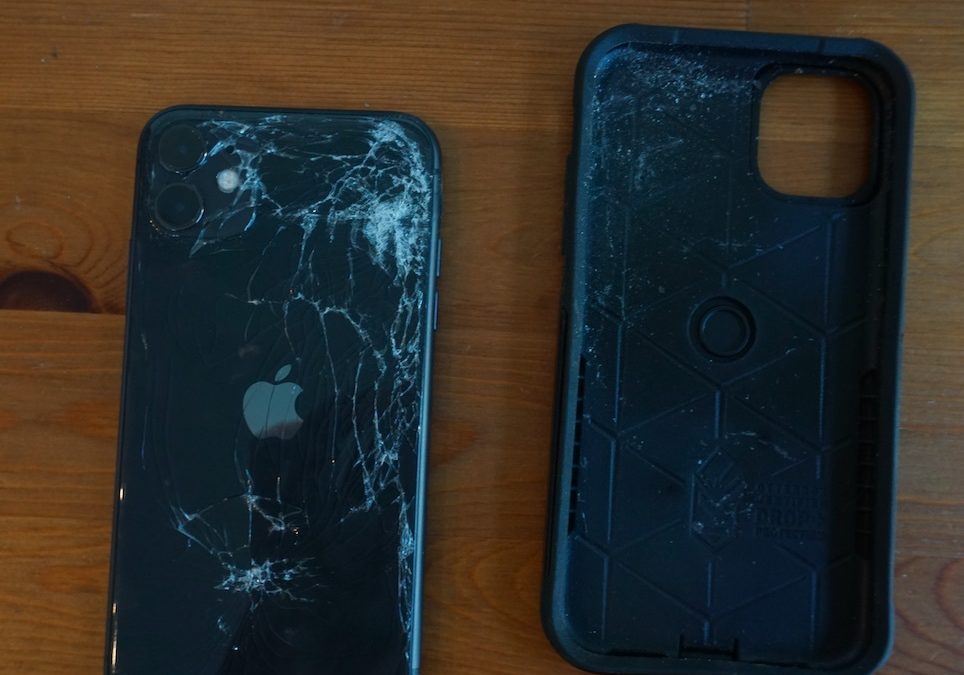Should you ride with a cell phone?
Is carrying a smartphone a bad idea? Or a huge help?

I’ve had quite a few crashes recently and, luckily, walked away with little more than scrapes, bruises and one broken thumb. My phones have not fared as well.
When the latest crash rendered a three-month-old phone totally shattered and irreparable, I started to wonder if it was worth it. Had I not been fine, I would have been very happy to use my ride buddy’s phone to call for help, of course. But, with bike and body (mostly) intact, I was left frustrated that another expensive phone was damaged and anxious about what the bill would be.
[Update: We ran a poll to see if readers ride with a phone and, if they do, how they keep it safe. Results at the bottom of this page]

The case against cell phones on mountain bike rides
Damaging an expensive phone is the most obvious reason not to bring it with you into the woods. Phones are expensive these days. The latest and greatest are solidly in the four-figure price range, with older models still setting you back several hundred dollars. Despite the price, they’re also quite fragile. Or, at least, not particularly designed to survive in an outdoor environment. That means that breaking one is both likely, costly and a total bummer.
On the more ephemeral side of things, many of us ride to escape. To get away from the noise of the city and the distraction of screens, cars and, well, phones. Bringing your digital leash into the woods can be a distraction or, more simply, keeps us tethered to the stress of everyday life that we’re trying to escape. Plus, there’s always that one friend (which has, I’ll be honest, been me at times) that needs to stop every ten feet to take a picture of the best tree ever, the coolest fog ever or the sickest jump ever and totally breaks up the rhythm of the ride.

The case for cell phones on mountain bike rides
While the financial risk of destroying a phone makes it easy to leave it in the car, there are compelling reasons to have one on the ride, too. Being able to be reached – or reach out – in case of an emergency is important, maps are useful and most phones come with amazing cameras these days.
Having a phone to contact the outside world in case of an emergency is important. Mountain biking is a risky sport, and accidents will happen. Having a way to call for help when things go really wrong can make a huge difference. Phones are good in non-emergency situations, too, even if it’s just calling for a ride home when you smash a rim or break a chain. Even the most prepared rider will eventually run into a problem that they can’t fix.
With the rise of smartphones, you can now bring incredible maps into the woods with you, too. Apps can help navigate trail networks or more detailed topographical information (and even educational maps, so you can learn and ride) to keep you from getting lost or help find your way out if you do. If you’re going way off-grid, having a paper map as a backup is a solid idea. But if you’re just out for a quick rip in a new area, map apps can make navigation much less painful and, if something does happen, help give better information about your location to emergency services.
Last, phones do come with incredible cameras these days. Having a few photos from your rides isn’t essential, but it is nice. Even if you’re not an aspiring influencer and never “do anything” with the photos, having memories from great rides is a good thing. Especially when it’s mid-January and you’re trying to find a reason to get back in the gym or log onto Zwift again. Looking back at the last year’s adventures is an easy way to get motivated for new epics.

A question of cases?
So, if you’re bringing your phone into the woods, how do you keep it safe? A proper case can help. So can storing it somewhere away from potential damage.
Protecting some kind of case is a basic requirement, just for everyday life if you’re as clumsy as I am. But there are better and worse cases if you’re heading into the woods often. The trade-off is usually that better protection comes from bulkier cases. A bit of added heft can be worth it, though, when you’re protecting a phone that costs hundreds of dollars, or even a thousand, to replace.
If you don’t go for a bomb-proof case, proper placement can help. That means no putting phones in jersey or shorts pockets. That just makes them expensive padding by putting them between you and the ground when you fall. Most riding packs, hip and backpacks, now come with a scratch-proof pocket specifically designed to hold valuables like phones or sunglasses.
Verdict: Always on call? Or hang up on phones during rides?
So, what’s the verdict? We still think, despite the occasional distractions, that riding with a phone is worth the risk for emergency use alone. Mapping and photos are an added, if not essential bonus. That doesn’t mean everyone on a group ride needs to be carrying. If you really want to unplug, make sure at least two people (in case one breaks a phone) on your group ride have some way of calling for help should the need arise.
Do you ride with a cellphone? Have you found a case that works for you? We’ve got a poll going in our Instagram stories. Head over and let us know what’s worked, or really not worked for you.
Update: We asked for your feedback on Instagram, and you responded. Based on your answers, breaking a phone is either something that’s happened to you, or something many of you think will never happen to you. Keeping your phone in a backpack or hip bag seems to be the best suggestion. Keeping your phone in a zippered pocket was also popular, though I’ll add that I’ve broken two phones and another screen of another, all while safely stashed in my pocket (Maybe I just need to learn to stay on my bike?).
There were also a wide range of protective case suggestions. Lifeproof, Spigen, OtterBox, Quad Lock (we really don’t recommend bar-mounted smartphones, but you do you) and Mous cases all came up several times. They offer a range of waterproof and drop protection, depending how much you want to spend and how big of a case you’re willing to put up with.
What’s the answer? Depends how risky you want to be. Hiding it in a bag, inside a solid case is the safest option and makes the most sense. Will I do that every ride? … probably not. Will I ever put a phone in a shorts or pants pocket while riding? I really shouldn’t. That seems to be the most likely place to damage a phone, but also the most comfortable to ride with.
